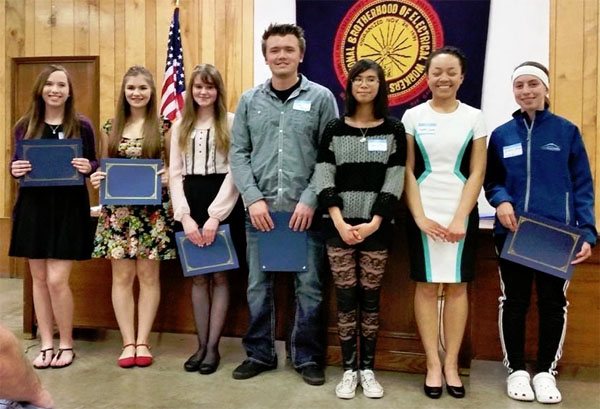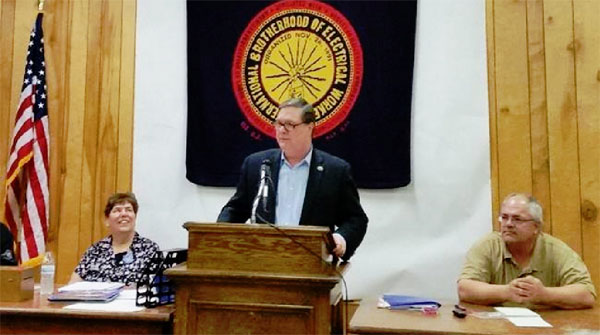LOCAL
Celebrating 125 years of proud labor history in Pierce County
By JEFF JOHNSON
TACOMA (April 10, 2015) — I had the honor to attend the Pierce County Central Labor Council meeting on Wednesday, April 8, which was significant for a number of reasons.
 First the PCCLC awarded seven scholarships, ranging from $500 to $1,500, to graduating high school students who are attending community and technical colleges or universities next fall (pictured at right). These scholarships, named after long-time Labor Community Services Representative and PCCLC delegate Jerry Beckendorf, are awarded to the sons and daughters of union members who show great promise. So far, 100 scholarships have been awarded to deserving young people.
First the PCCLC awarded seven scholarships, ranging from $500 to $1,500, to graduating high school students who are attending community and technical colleges or universities next fall (pictured at right). These scholarships, named after long-time Labor Community Services Representative and PCCLC delegate Jerry Beckendorf, are awarded to the sons and daughters of union members who show great promise. So far, 100 scholarships have been awarded to deserving young people.
Also on Wednesday, the Pierce County CLC celebrated its 125th anniversary. The history of the PCCLC is a testament to the resilience, solidarity, and need for organized labor in Pierce County.
 Joining the delegates were Congressman Denny Heck (D-10th), who gave a wonderful speech honoring both the students and the CLC (pictured at left with PCCLC Secretary-Treasurer Patty Rose and President Vance Lelli); a representative for Congressman Derek Kilmer, who had a statement honoring the Pierce CLC read into the Congressional Record; state Sen. Jeannie Darnielle (D-Tacoma); and Rep. Steve Kirby (D-Tacoma).
Joining the delegates were Congressman Denny Heck (D-10th), who gave a wonderful speech honoring both the students and the CLC (pictured at left with PCCLC Secretary-Treasurer Patty Rose and President Vance Lelli); a representative for Congressman Derek Kilmer, who had a statement honoring the Pierce CLC read into the Congressional Record; state Sen. Jeannie Darnielle (D-Tacoma); and Rep. Steve Kirby (D-Tacoma).
PCCLC Secretary-Treasurer Patty Rose read to the audience the following historical summary of the council, which I asked her to send to us to be published in The Stand. I hope you enjoy this history as much as we did Wednesday night.
On April 3, 1890, Labor Solidarity was born in Tacoma when representatives from eight Tacoma trade unions met on a Thursday evening at the Alpha Opera House, which had public meeting space (9th and Pacific – current site of the Bank of California) to form the Tacoma Trades Council, the predecessor of today’s Pierce County Central Labor Council, AFL-CIO.
The eight unions were the Cigar Makers, Carpenters, Stone Cutters, Bricklayers, Iron Molders, Tinners and Cornice Makers, Longshoremen, and the Knights Assembly 4223. Charles Drees, a Socialist cigarmaker, presided. George L. McMurphy, a New England Republican carpenter recorded the minutes.
The council’s original purpose was to provide a legal organization to acquire land and build a hall. The City Council had recently provided the Chamber of Commerce ground for a building, and Union people thought that if the City could provide the Chamber land, they could well afford a site for the equally important working men. That intent was soon overshadowed by the pressing needs of a union movement struggling to organize and protect working people.
As a united labor movement supporting each other, they aided groups of workers that were too weak to improve their conditions alone. A standing organizing committee helped the Shipwrights and Caulkers, Journeymen Horseshoers, and other unions to organize. 125 years later, the PCCLC, AFL-CIO has 89 affiliates, representing more than 37,000 workers in Pierce County.
Our mission continues to be to improve the lives of working people and their families and gain greater respect, a better standard of living and employment stability for our members and our community.
Printers working on the two daily newspapers organized the first union, Tacoma Typographical Union 170 on September 30, 1883. Second: Mt. Tacoma Lodge 238, Brotherhood of Locomotive Engineers (1-3-1884). Third: Mt. Tacoma Lodge 192 – Brotherhood of Locomotive Firemen (1-4-1884).
Upsurge of union organizing occurred in 1887-1890 – the drive for shorter hours of labor was the dominate issue.
Population in 1890 was 36,000.
When Samuel Gompers, President of the AFL, visited Tacoma in 1892, the council welcomed him with a carriage procession of local union presidents and a 110 piece band of union musicians, and sponsored a public meeting for him.
Labor Day parades of 1890/1891/1892 were splendid affairs, reflecting the pride and optimism of the young union movement. Buildings were decorated and shops closed. Work ceased so the workers could participate in the parade or watch along Pacific Avenue.
The panic of 1893 hit Tacoma. 14 of the city’s 21 banks closed. Many businesses failed. Unemployment soared. Minutes from the 7-6-1893 Trades Council reported trade in a deplorable condition.
August 15, 1893 – the final blow came when the Northern Pacific railroad declared bankruptcy. Severe economic depression settled over Tacoma. Nov. 1893 – the Trades Council had $3.45 in the treasury. Many unions withdrew from the council because they couldn’t afford the $3.00 per month per capita tax. The Trades Council had $141.35 in the Labor Day fund, which was used to buy groceries for destitute families.
Tacoma’s population shrunk to 42,459 in 1897.
Alexander Drummond, an immigrant tailor from Scotland, and the last treasurer of the Council, held $57.30 in trust to turn over to the council when it met again. The union movement was dormant, but not dead.
Prosperity returned rapidly in the Puget Sound region during the last years of the 19th century. Tacoma workers revived their dormant unions or organized new ones demanding their share of the increasing prosperity.
Representatives of the Iron Molders, Plumbers, Cigar Makers, Typographical Union, Electrical Workers Local 76, Brotherhood of Locomotive Firemen, Bricklayers, Brewery workers and Millmen met on Nov. 13, 1899 to reorganize the Tacoma Trades Council.
The Union upsurge was at its height. On January 8, 1900 the Trades Council meeting recessed for an hour to allow the carpenters to use the hall to organize.
1903 – The Tacoma Trades Council was employing a business agent part time.
1907 – The Tacoma Trades Council met for the last time on Sept. 30, 1907.
November 5, 1907 – Tacoma Trades Council and Building Trades Assembly merged to become the Tacoma Central Labor Council. David A. Maulsby, a republican printer was elected president. Thomas Burns, a socialist cigar maker, was elected business agent at $25.00 a week.
Feb. 1908, a council committee was appointed to devise ways to acquire a labor temple. Unions pledged to buy stock to finance the building. In 1910, down payment was made on two lots on Tacoma Avenue and the Labor Temple Corporation was formed. The drive stalled in 1913, lacking $1,600 to pay off the indebtedness on the lots. (The lots on Tacoma Avenue were later exchanged for lots at 13th and Market)
March 1909 – the weekly Tacoma Labor Advocate began publication (but owned and edited by F. W. Cameron) which proved unsatisfactory. The council purchased it for $200 in Nov. 1910 and elected George W. Dunn of the Typographical union to be the managing editor. From a press run of 1,000 copies printed for $20, the paper gained circulation steadily as unions subscribed for bundles.
1917 – Labor Temple Corp leased the 2nd floor of a new building on the corner of 13th and Broadway for offices and meeting halls of the CLC and a number of unions.
1924 – moved to the City Hall Annex at 621 Pacific Avenue (the old Northern Pacific headquarters building) and the next year the Labor Advocate printing plant was installed there.
Depression years took a toll on workers and their unions, but in the spring of 1933 – lumber and shipping began to recover. The CLC elected Harry McIlvaigh (a railroad machinist on the Milwaukee Railroad)) as secretary
Paddy Morris, Longshoremen’s organizer was president of the council
(Harry McIlvaigh would serve 30 years as Secretary/Treasurer 1933-1963)
Membership in the CLC was around 50 locals with about 5,000 members
By 1938, the CLC had doubled, adding 42 new locals with an additional 8,000 workers
1941 – after 17 years in the City Hall Annex, the CLC moved to the Baker Hotel at 15th & Market. Union members donated one day’s pay to purchase it. Remodeling began and the Council and unions moved in in Oct. 1941. The Labor Advocate (including a job printing shop) was on the main floor. Offices, meeting halls, a lounge and lunch counter were also there. The Building was paid off in 1943. (an earthquake would later make the building unsafe)
CLC membership was 36,000
1941 – John McGivney retired as editor of the Labor Advocate, succeeded by Ralph Chaplin (for 4 years) who used his talents to make the Advocate one of the best labor papers in the country. He also hosted the radio program, “Voice of Labor” sponsored by the council.
1944 – L. H. Bates Vocational-Technical Institute was established (now Bates Technical College) where union workers, like Jack Skanes, worked as a union carpenter during the day and taught the craft to others in the evening at Bates in conjunction with the apprenticeship training programs. Apprentice programs train more workers than any other entity except the US Military.
1946 – After World War II, it became apparent Tacoma needed a safe and constant supply of blood and blood products. The medical community and labor partnered to form the Tacoma Pierce County Blood Bank (now Cascade Regional Blood Services) Union members purchased $1.00 membership cards which raised $30,000 to start the blood bank in a rented store front at 728 ½ St Helens Avenue.
(69 years later – Blood Bank employees are still represented by OPEIU #23, one of only 5 or 6 union blood banks in the country).
1948 – Tacoma Unions supported the strike/lockout of clerks in retail stores for a wage increase for women, equal to the amount being offered to the men. After 11 weeks, 14 craft unions of store employees won the equal wage increase and other improvements in an agreement signed by the CLC and the Building Trades Council.
1951 – The labor community bought a new printing press for the Labor Advocate with voluntary assessments of $1.00 from union members.
1955 – with the merger of AFL and CIO, the Tacoma Central Labor Council became Pierce County Central Labor Council, AFL-CIO on Oct. 25, 1907.
1955 – Initiative 198 – Right to Work and Initiative 202 in 1957 – overwhelmingly defeated.
In the 1960’s, a decision was made to build on land at 11th and Fawcett. Ground was broken in 1971, but construction costs were severely underestimated – the Labor Temple Corp. had to borrow a substantial amount of money from the Labor Advocate reserves. The CLC and many other unions moved in in 1972.
Clyde Hupp was elected S/T in 1977 and soon discovered both the Labor Temple Corp and the Labor Advocate were bankrupt. They had to fold the Advocate and sell the building. The PCCLC moved to our present location at the IBEW 76 Hall in 1978.
1997 – The CLC formed the Pierce County Labor Community Services Agency to help union brothers and sisters during times of unexpected financial need or emergency.
2003 – The Jerry Beckendorf Community Service Scholarship was started to provide scholarships to graduating Pierce County High School seniors, with at least one parent a union member. We have given 100 students scholarships totaling $66,920 as of 4/8/15)
2011 – The annual peanut butter drive began. Delegates were asked to bring Union made JIF peanut butter to the May delegate meeting and 173 jars were brought in that first year. In 2012, 2031 jars were donated; 5,021 jars in 2013 and 5,512 in 2014. This year’s weigh-in is on May 13th. Nearly 13,000 jars of peanut butter, with a value of approximately $65,000 has been donated to the Emergency Food Network as part of the letter carriers food drive.
We have a wonderful labor history in Tacoma and Pierce County and I’m happy for the chance to share some of it with you on our 125th Anniversary.
— Patty Rose, Secretary Treasurer, Pierce County Central Labor Council, AFL-CIO (April 3, 2015)
** Much of the information in this article was compiled for the 100th Anniversary of the Pierce County Central Labor Council, and appears in the book, To Live in Dignity. Ottilie Markholt deserves much of the credit for her research and knowledge of local labor history.
 Jeff Johnson is President of the Washington State Labor Council, AFL-CIO, the largest labor organization in the Evergreen State, representing the interests of more than 500 local unions and 400,000 rank-and-file union members.
Jeff Johnson is President of the Washington State Labor Council, AFL-CIO, the largest labor organization in the Evergreen State, representing the interests of more than 500 local unions and 400,000 rank-and-file union members.





